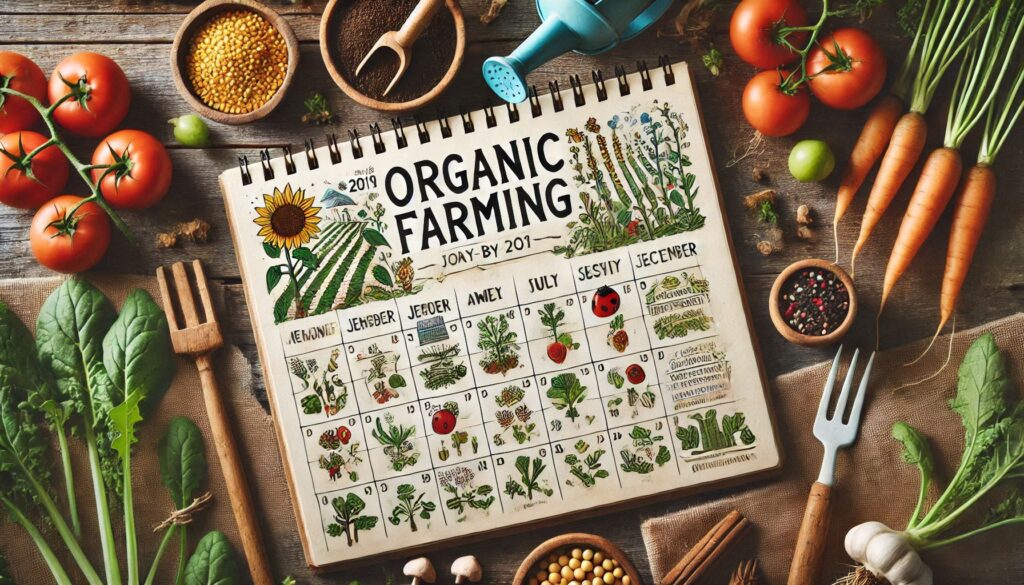
Organic farming: 1-365 Organic farming harmonizes with nature, boosting biodiversity, soil health & producing chemical-free food. Explore its seasonal rhythms!
Organic farming is more than just a method of cultivation; it’s a way of living in harmony with nature. It promotes biodiversity, improves soil health, and ensures the production of high-quality, chemical-free food. To truly understand organic farming, one must experience its seasonal rhythms. This blog will take you on a day-by-day journey through a year of organic farming, providing insights, tips, and practices for every month.
January: Setting the Stage for Success
January is the month of planning and preparation. Farmers focus on reviewing the previous year’s performance and setting goals for the year ahead. Key tasks include soil testing, planning crop rotations, and repairing tools and machinery. This foundational work ensures a strong start to the growing season.
- Highlight: Preparing seed catalogs and planning purchases for the year.
- Tip: Conduct a soil health test to identify nutrient deficiencies.
February: Gearing Up for the Growing Season
As winter persists, February offers an opportunity to refine plans and start indoor activities. Farmers prepare seed trays for early sowing, maintain greenhouses, and apply compost to fields.
- Highlight: Setting up seed trays for early planting indoors.
- Tip: Use organic compost to enrich soil for the upcoming growing season.
March: Welcoming Early Growth
March marks the transition from winter to spring. Farmers begin sowing cold-hardy crops like spinach and carrots. Greenhouses are bustling with seedlings, and fields are prepared for planting.
- Highlight: Direct sowing of hardy crops.
- Tip: Protect seedlings with row covers to guard against late frosts.
April: Spring in Full Swing
April is a busy month as the planting season peaks. Farmers transplant seedlings, prepare irrigation systems, and monitor pest activity. Cover crops are tilled into the soil to improve fertility.
- Highlight: Planting a variety of spring crops.
- Tip: Use organic pest deterrents like neem oil to control infestations.
May: Nurturing Growth
May is the time to nurture young crops. Farmers focus on weeding, thinning, and monitoring plant health. Livestock care also intensifies as pastures become more active.
- Highlight: Installing irrigation systems for efficient water use.
- Tip: Mulch around plants to retain soil moisture and suppress weeds.
June: Thriving Fields
June brings longer days and faster plant growth. Farmers concentrate on fertilization, pruning, and ensuring adequate water supply.
- Highlight: Fertilizing crops with organic manure.
- Tip: Regularly scout for pests and diseases to prevent outbreaks.
July: Managing Peak Activity
July is one of the busiest months in organic farming. Harvesting early crops, planting successions, and managing pest control are top priorities.
- Highlight: Harvesting summer vegetables like tomatoes and cucumbers.
- Tip: Rotate crops to prevent soil depletion and reduce pests.
August: Preparing for Transition
In August, farmers focus on preparing for the fall season while continuing summer harvests. Composting and cover cropping become essential tasks.
- Highlight: Planting fall crops such as broccoli and kale.
- Tip: Start preparing fields for winter cover crops.
September: Harvest and Preserve
September is a time of abundance. Farmers harvest late-summer crops and start preserving produce for winter.
- Highlight: Storing harvested crops like potatoes and onions.
- Tip: Use organic methods to manage weeds and prepare soil for winter.
October: Wrapping Up the Season
October is the month to finalize harvests and prepare for winter. Cover crops are planted, and fields are mulched to protect soil from erosion.
- Highlight: Planting garlic for next year’s harvest.
- Tip: Winterize equipment to prevent damage from freezing temperatures.
November: Winter Preparation
November is dedicated to winter preparations. Farmers focus on maintaining soil health, protecting livestock, and storing tools and crops.
- Highlight: Planting winter cover crops like rye.
- Tip: Insulate water sources to prevent freezing.
December: Reflecting and Planning
December is a reflective month to review the year’s achievements and challenges. Farmers set goals for the next year and maintain their fields and livestock through winter.
- Highlight: Reviewing soil fertility and planning crop rotations.
- Tip: Engage in farm community activities to share knowledge and resources.

Conclusion: Embracing the Organic Lifestyle
Organic farming is a year-round commitment to sustainable agriculture. Each month offers unique tasks and opportunities to nurture the land, protect the environment, and produce healthy food. By following this day-by-day guide, you can align with nature’s rhythms and make the most of every season in your organic farming journey.
Here are the answers to your five questions based on organic farming principle
- January tasks: Plan for the season, analyze soil, order seeds, maintain tools, and prepare crop rotations.
- Pest protection in June/July: Use natural predators, row covers, organic pesticides, crop rotation, and regular inspections.
- Cover crop benefits: Prevent erosion, improve fertility, suppress weeds, and enhance biodiversity; plant in fall or early spring.
- Crop rotation benefits: Maintains soil fertility, prevents pest buildup, and ensures diverse nutrient use.
- December planning: Review past season, adjust crop rotations, set goals, research new practices, and prepare for next season.



Your point of view caught my eye and was very interesting. Thanks. I have a question for you.
Just tried SuperPH26 and loved the 1024 paylines-it keeps you on your toes! The graphics are top-notch, and the wild symbols really boost your chances. Check it out at SuperPH26 Login!
I don’t think the title of your article matches the content lol. Just kidding, mainly because I had some doubts after reading the article.
https://www.r6messagenet.com/members/roscarpt.91823/
Thanks for sharing. I read many of your blog posts, cool, your blog is very good.
Can you be more specific about the content of your article? After reading it, I still have some doubts. Hope you can help me.
http://www.fanart-central.net/user/teenpattitopcom/profile
Great insights! It’s refreshing to see a platform like tyy.AI Tools streamline AI discovery for professionals. Their AI SEO Assistant is a game-changer for optimizing workflows.
I think, that you are not right. Write to me in PM, we will discuss.
https://ticketseiffeltowerfr.dreamwidth.org/
Thanks for sharing. I read many of your blog posts, cool, your blog is very good.
Thank you for your sharing. I am worried that I lack creative ideas. It is your article that makes me full of hope. Thank you. But, I have a question, can you help me?